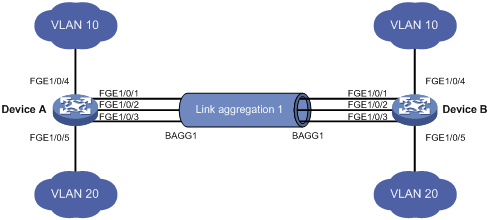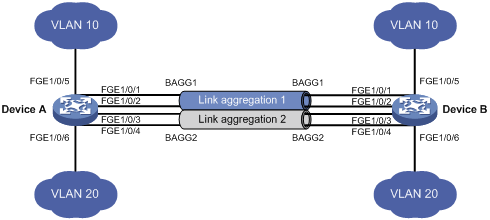请问华三交换机6900怎样配置静态聚合!谢谢
- 0关注
- 1收藏,2883浏览
最佳答案

1.13.1 二层静态聚合配置举例
1. 组网需求
· Device A与Device B通过各自的二层以太网接口GigabitEthernet1/0/1~GigabitEthernet1/0/3相互连接。
· 在Device A和Device B上分别配置二层静态链路聚合组,并实现设备间VLAN 10和VLAN 20分别互通。
2. 组网图
图1-7 二层静态聚合配置组网图

3. 配置步骤
(1) 配置Device A
# 创建VLAN 10,并将端口GigabitEthernet1/0/4加入到该VLAN中。
<DeviceA> system-view
[DeviceA] vlan 10
[DeviceA-vlan10] port gigabitethernet 1/0/4
[DeviceA-vlan10] quit
# 创建VLAN 20,并将端口GigabitEthernet1/0/5加入到该VLAN中。
[DeviceA] vlan 20
[DeviceA-vlan20] port gigabitethernet 1/0/5
[DeviceA-vlan20] quit
# 创建二层聚合接口1。
[DeviceA] interface bridge-aggregation 1
[DeviceA-Bridge-Aggregation1] quit
# 分别将端口GigabitEthernet1/0/1至GigabitEthernet1/0/3加入到聚合组1中。
[DeviceA] interface gigabitethernet 1/0/1
[DeviceA-GigabitEthernet1/0/1] port link-aggregation group 1
[DeviceA-GigabitEthernet1/0/1] quit
[DeviceA] interface gigabitethernet 1/0/2
[DeviceA-GigabitEthernet1/0/2] port link-aggregation group 1
[DeviceA-GigabitEthernet1/0/2] quit
[DeviceA] interface gigabitethernet 1/0/3
[DeviceA-GigabitEthernet1/0/3] port link-aggregation group 1
[DeviceA-GigabitEthernet1/0/3] quit
# 配置二层聚合接口1为Trunk端口,并允许VLAN 10和20的报文通过。
[DeviceA] interface bridge-aggregation 1
[DeviceA-Bridge-Aggregation1] port link-type trunk
[DeviceA-Bridge-Aggregation1] port trunk permit vlan 10 20
[DeviceA-Bridge-Aggregation1] quit
(2) 配置Device B
Device B的配置与Device A相似,配置过程略。
4. 验证配置
# 查看Device A上所有聚合组的详细信息。
[DeviceA] display link-aggregation verbose
Loadsharing Type: Shar -- Loadsharing, NonS -- Non-Loadsharing
Port Status: S -- Selected, U -- Unselected, I -- Individual
Port: A -- Auto port, M -- Management port, R -- Reference port
Flags: A -- LACP_Activity, B -- LACP_Timeout, C -- Aggregation,
D -- Synchronization, E -- Collecting, F -- Distributing,
G -- Defaulted, H -- Expired
Aggregate Interface: Bridge-Aggregation1
Aggregation Mode: Static
Loadsharing Type: Shar
Management VLANs: None
Port Status Priority Oper-Key
GE1/0/1(R) S 32768 1
GE1/0/2 S 32768 1
GE1/0/3 S 32768 1
以上信息表明,聚合组1为负载分担类型的二层静态聚合组,包含有三个选中端口。
- 2020-11-06回答
- 评论(1)
- 举报
-
(0)
超人您好,按照您的方法,配置聚合口没有mac地址上来啊?

您好,请知:
以下是二层链路聚合、三层链路聚合的配置举例,请参考:
1.8 以太网链路聚合典型配置举例
1.8.1 二层静态聚合配置举例
1. 组网需求
· Device A与Device B通过各自的二层以太网接口FortyGigE1/0/1~FortyGigE1/0/3相互连接。
· 在Device A和Device B上分别配置二层静态链路聚合组,并实现设备间VLAN 10和VLAN 20分别互通。
2. 组网图
3. 配置步骤
# 创建VLAN 10,并将端口FortyGigE1/0/4加入到该VLAN中。
[DeviceA] vlan 10
[DeviceA-vlan10] port fortygige 1/0/4
[DeviceA-vlan10] quit
# 创建VLAN 20,并将端口FortyGigE1/0/5加入到该VLAN中。
[DeviceA-vlan20] port fortygige 1/0/5
[DeviceA-vlan20] quit
# 创建二层聚合接口1。
[DeviceA] interface bridge-aggregation 1
[DeviceA-Bridge-Aggregation1] quit
# 分别将端口FortyGigE1/0/1至FortyGigE1/0/3加入到聚合组1中。
[DeviceA] interface fortygige 1/0/1
[DeviceA-FortyGigE1/0/1] port link-aggregation group 1
[DeviceA-FortyGigE1/0/1] quit
[DeviceA] interface fortygige 1/0/2
[DeviceA-FortyGigE1/0/2] port link-aggregation group 1
[DeviceA-FortyGigE1/0/2] quit
[DeviceA] interface fortygige 1/0/3
[DeviceA-FortyGigE1/0/3] port link-aggregation group 1
[DeviceA-FortyGigE1/0/3] quit
# 配置二层聚合接口1为Trunk端口,并允许VLAN 10和20的报文通过。
[DeviceA] interface bridge-aggregation 1
[DeviceA-Bridge-Aggregation1] port link-type trunk
[DeviceA-Bridge-Aggregation1] port trunk permit vlan 10 20
[DeviceA-Bridge-Aggregation1] quit
Device B的配置与Device A相似,配置过程略。
4. 验证配置
# 查看Device A上所有聚合组的详细信息。
[DeviceA] display link-aggregation verbose
Loadsharing Type: Shar -- Loadsharing, NonS -- Non-Loadsharing
Port Status: S -- Selected, U -- Unselected, I -- Individual
Flags: A -- LACP_Activity, B -- LACP_Timeout, C -- Aggregation,
D -- Synchronization, E -- Collecting, F -- Distributing,
G -- Defaulted, H -- Expired
Aggregate Interface: Bridge-Aggregation1
Aggregation Mode: Static
Loadsharing Type: Shar
Port Status Priority Oper-Key
--------------------------------------------------------------------------------
FGE1/0/1 S 32768 1
FGE1/0/2 S 32768 1
FGE1/0/3 S 32768 1
以上信息表明,聚合组1为二层静态聚合组,包含有三个选中端口。
1.8.2 二层动态聚合配置举例
1. 组网需求
· Device A与Device B通过各自的二层以太网接口FortyGigE1/0/1~FortyGigE1/0/3相互连接。
· 在Device A和Device B上分别配置二层动态链路聚合组,并实现设备间VLAN 10和VLAN 20分别互通。
2. 组网图
3. 配置步骤
# 创建VLAN 10,并将端口FortyGigE1/0/4加入到该VLAN中。
[DeviceA] vlan 10
[DeviceA-vlan10] port fortygige 1/0/4
[DeviceA-vlan10] quit
# 创建VLAN 20,并将端口FortyGigE1/0/5加入到该VLAN中。
[DeviceA-vlan20] port fortygige 1/0/5
[DeviceA-vlan20] quit
# 创建二层聚合接口1,并配置该接口为动态聚合模式。
[DeviceA] interface bridge-aggregation 1
[DeviceA-Bridge-Aggregation1] link-aggregation mode dynamic
[DeviceA-Bridge-Aggregation1] quit
# 分别将端口FortyGigE1/0/1至FortyGigE1/0/3加入到聚合组1中。
[DeviceA] interface fortygige 1/0/1
[DeviceA-FortyGigE1/0/1] port link-aggregation group 1
[DeviceA-FortyGigE1/0/1] quit
[DeviceA] interface fortygige 1/0/2
[DeviceA-FortyGigE1/0/2] port link-aggregation group 1
[DeviceA-FortyGigE1/0/2] quit
[DeviceA] interface fortygige 1/0/3
[DeviceA-FortyGigE1/0/3] port link-aggregation group 1
[DeviceA-FortyGigE1/0/3] quit
# 配置二层聚合接口1为Trunk端口,并允许VLAN 10和20的报文通过。
[DeviceA] interface bridge-aggregation 1
[DeviceA-Bridge-Aggregation1] port link-type trunk
[DeviceA-Bridge-Aggregation1] port trunk permit vlan 10 20
[DeviceA-Bridge-Aggregation1] quit
Device B的配置与Device A相似,配置过程略。
4. 验证配置
# 查看Device A上所有聚合组的详细信息。
[DeviceA] display link-aggregation verbose
Loadsharing Type: Shar -- Loadsharing, NonS -- Non-Loadsharing
Port Status: S -- Selected, U -- Unselected, I -- Individual
Flags: A -- LACP_Activity, B -- LACP_Timeout, C -- Aggregation,
D -- Synchronization, E -- Collecting, F -- Distributing,
G -- Defaulted, H -- Expired
Aggregate Interface: Bridge-Aggregation1
Aggregation Mode: Dynamic
Loadsharing Type: Shar
System ID: 0x8000, 000f-e267-6c6a
Local:
Port Status Priority Oper-Key Flag
--------------------------------------------------------------------------------
FGE1/0/1 S 32768 1 {ACDEF}
FGE1/0/2 S 32768 1 {ACDEF}
FGE1/0/3 S 32768 1 {ACDEF}
Remote:
Actor Partner Priority Oper-Key SystemID Flag
--------------------------------------------------------------------------------
FGE1/0/1 1 32768 1 0x8000, 000f-e267-57ad {ACDEF}
FGE1/0/2 2 32768 1 0x8000, 000f-e267-57ad {ACDEF}
FGE1/0/3 3 32768 1 0x8000, 000f-e267-57ad {ACDEF}
以上信息表明,聚合组1为二层动态聚合组,包含有三个选中端口。
1.8.3 二层聚合负载分担配置举例
1. 组网需求
· Device A与Device B通过各自的二层以太网接口FortyGigE1/0/1~FortyGigE1/0/4相互连接。
· 在Device A和Device B上分别配置两个二层静态链路聚合组,并使两端的VLAN 10通过二层聚合接口1互通、VLAN 20通过二层聚合接口2互通。
· 通过在聚合组1上按照源MAC地址进行聚合负载分担、在聚合组2上按照目的MAC地址进行聚合负载分担的方式,来实现数据流量在各成员端口间的负载分担。
2. 组网图
3. 配置步骤
# 创建VLAN 10,并将端口FortyGigE1/0/5加入到该VLAN中。
[DeviceA] vlan 10
[DeviceA-vlan10] port fortygige 1/0/5
[DeviceA-vlan10] quit
# 创建VLAN 20,并将端口FortyGigE1/0/6加入到该VLAN中。
[DeviceA-vlan20] port fortygige 1/0/6
[DeviceA-vlan20] quit
# 创建二层聚合接口1,并配置该接口对应的聚合组内按照源MAC地址进行聚合负载分担。
[DeviceA] interface bridge-aggregation 1
[DeviceA-Bridge-Aggregation1] link-aggregation load-sharing mode source-mac
[DeviceA-Bridge-Aggregation1] quit
# 分别将端口FortyGigE1/0/1和FortyGigE1/0/2加入到聚合组1中。
[DeviceA] interface fortygige 1/0/1
[DeviceA-FortyGigE1/0/1] port link-aggregation group 1
[DeviceA-FortyGigE1/0/1] quit
[DeviceA] interface fortygige 1/0/2
[DeviceA-FortyGigE1/0/2] port link-aggregation group 1
[DeviceA-FortyGigE1/0/2] quit
# 配置二层聚合接口1为Trunk端口,并允许VLAN 10的报文通过。
[DeviceA] interface bridge-aggregation 1
[DeviceA-Bridge-Aggregation1] port link-type trunk
[DeviceA-Bridge-Aggregation1] port trunk permit vlan 10
[DeviceA-Bridge-Aggregation1] quit
# 创建二层聚合接口2,并配置该接口对应的聚合组内按照目的MAC地址进行聚合负载分担。
[DeviceA] interface bridge-aggregation 2
[DeviceA-Bridge-Aggregation2] link-aggregation load-sharing mode destination-mac
[DeviceA-Bridge-Aggregation2] quit
# 分别将端口FortyGigE1/0/3和FortyGigE1/0/4加入到聚合组2中。
[DeviceA] interface fortygige 1/0/3
[DeviceA-FortyGigE1/0/3] port link-aggregation group 2
[DeviceA-FortyGigE1/0/3] quit
[DeviceA] interface fortygige 1/0/4
[DeviceA-FortyGigE1/0/4] port link-aggregation group 2
[DeviceA-FortyGigE1/0/4] quit
# 配置二层聚合接口2为Trunk端口,并允许VLAN 20的报文通过。
[DeviceA] interface bridge-aggregation 2
[DeviceA-Bridge-Aggregation2] port link-type trunk
[DeviceA-Bridge-Aggregation2] port trunk permit vlan 20
[DeviceA-Bridge-Aggregation2] quit
Device B的配置与Device A相似,配置过程略。
4. 验证配置
# 查看Device A上所有聚合组的详细信息。
[DeviceA] display link-aggregation verbose
Loadsharing Type: Shar -- Loadsharing, NonS -- Non-Loadsharing
Port Status: S -- Selected, U -- Unselected, I -- Individual
Flags: A -- LACP_Activity, B -- LACP_Timeout, C -- Aggregation,
D -- Synchronization, E -- Collecting, F -- Distributing,
G -- Defaulted, H -- Expired
Aggregate Interface: Bridge-Aggregation1
Aggregation Mode: Static
Loadsharing Type: Shar
Port Status Priority Oper-Key
--------------------------------------------------------------------------------
FGE1/0/1 S 32768 1
FGE1/0/2 S 32768 1
Aggregate Interface: Bridge-Aggregation2
Aggregation Mode: Static
Loadsharing Type: Shar
Port Status Priority Oper-Key
--------------------------------------------------------------------------------
FGE1/0/3 S 32768 2
FGE1/0/4 S 32768 2
以上信息表明,聚合组1和聚合组2都是负载分担类型的二层静态聚合组,各包含有两个选中端口。
# 查看Device A上所有聚合接口所对应聚合组内采用的聚合负载分担类型。
[DeviceA] display link-aggregation load-sharing mode interface
Bridge-Aggregation1 Load-Sharing Mode:
source-mac address
Bridge-Aggregation2 Load-Sharing Mode:
destination-mac address
以上信息表明,二层聚合组1按照报文的源MAC地址进行聚合负载分担,二层聚合组2按照报文的目的MAC地址进行聚合负载分担。
1.8.4 三层静态聚合配置举例
1. 组网需求
· Device A与Device B通过各自的三层以太网接口FortyGigE1/0/1~FortyGigE1/0/3相互连接。
· 在Device A和Device B上分别配置三层静态链路聚合组,并为对应的三层聚合接口配置IP地址和子网掩码。
2. 组网图
3. 配置步骤
# 创建三层聚合接口1,并为该接口配置IP地址和子网掩码。
[DeviceA] interface route-aggregation 1
[DeviceA-Route-Aggregation1] ip address 192.168.1.1 24
[DeviceA-Route-Aggregation1] quit
# 分别将接口FortyGigE1/0/1至FortyGigE1/0/3加入到聚合组1中。
[DeviceA] interface fortygige 1/0/1
[DeviceA-FortyGigE1/0/1] port link-aggregation group 1
[DeviceA-FortyGigE1/0/1] quit
[DeviceA] interface fortygige 1/0/2
[DeviceA-FortyGigE1/0/2] port link-aggregation group 1
[DeviceA-FortyGigE1/0/2] quit
[DeviceA] interface fortygige 1/0/3
[DeviceA-FortyGigE1/0/3] port link-aggregation group 1
[DeviceA-FortyGigE1/0/3] quit
Device B的配置与Device A相似,配置过程略。
4. 验证配置
# 查看Device A上所有聚合组的详细信息。
[DeviceA] display link-aggregation verbose
Loadsharing Type: Shar -- Loadsharing, NonS -- Non-Loadsharing
Port Status: S -- Selected, U -- Unselected, I -- Individual
Flags: A -- LACP_Activity, B -- LACP_Timeout, C -- Aggregation,
D -- Synchronization, E -- Collecting, F -- Distributing,
G -- Defaulted, H -- Expired
Aggregate Interface: Route-Aggregation1
Aggregation Mode: Static
Loadsharing Type: Shar
Port Status Priority Oper-Key
--------------------------------------------------------------------------------
FGE1/0/1 S 32768 1
FGE1/0/2 S 32768 1
FGE1/0/3 S 32768 1
以上信息表明,聚合组1为非负载分担类型的三层静态聚合组,包含有三个选中端口。
1.8.5 三层动态聚合配置举例
1. 组网需求
· Device A与Device B通过各自的三层以太网接口FortyGigE1/0/1~FortyGigE1/0/3相互连接。
· 在Device A和Device B上分别配置三层动态链路聚合组,并为对应的三层聚合接口配置IP地址和子网掩码。
2. 组网图
3. 配置步骤
# 创建三层聚合接口1,配置该接口为动态聚合模式,并为其配置IP地址和子网掩码。
[DeviceA] interface route-aggregation 1
[DeviceA-Route-Aggregation1] link-aggregation mode dynamic
[DeviceA-Route-Aggregation1] ip address 192.168.1.1 24
[DeviceA-Route-Aggregation1] quit
# 分别将接口FortyGigE1/0/1至FortyGigE1/0/3加入到聚合组1中。
[DeviceA] interface fortygige 1/0/1
[DeviceA-FortyGigE1/0/1] port link-aggregation group 1
[DeviceA-FortyGigE1/0/1] quit
[DeviceA] interface fortygige 1/0/2
[DeviceA-FortyGigE1/0/2] port link-aggregation group 1
[DeviceA-FortyGigE1/0/2] quit
[DeviceA] interface fortygige 1/0/3
[DeviceA-FortyGigE1/0/3] port link-aggregation group 1
[DeviceA-FortyGigE1/0/3] quit
Device B的配置与Device A相似,配置过程略。
4. 验证配置
# 查看Device A上所有聚合组的详细信息。
[DeviceA] display link-aggregation verbose
Loadsharing Type: Shar -- Loadsharing, NonS -- Non-Loadsharing
Port Status: S -- Selected, U -- Unselected, I -- Individual
Flags: A -- LACP_Activity, B -- LACP_Timeout, C -- Aggregation,
D -- Synchronization, E -- Collecting, F -- Distributing,
G -- Defaulted, H -- Expired
Aggregate Interface: Route-Aggregation1
Aggregation Mode: Dynamic
Loadsharing Type: Shar
System ID: 0x8000, 000f-e267-6c6a
Local:
Port Status Priority Oper-Key Flag
--------------------------------------------------------------------------------
FGE1/0/1 S 32768 1 {ACDEF}
FGE1/0/2 S 32768 1 {ACDEF}
FGE1/0/3 S 32768 1 {ACDEF}
Remote:
Actor Partner Priority Oper-Key SystemID Flag
--------------------------------------------------------------------------------
FGE1/0/1 1 32768 1 0x8000, 000f-e267-57ad {ACDEF}
FGE1/0/2 2 32768 1 0x8000, 000f-e267-57ad {ACDEF}
FGE1/0/3 3 32768 1 0x8000, 000f-e267-57ad {ACDEF}
以上信息表明,聚合组1为非负载分担类型的三层动态聚合组,包含有三个选中端口。
- 2020-11-06回答
- 评论(0)
- 举报
-
(0)
编辑答案


亲~登录后才可以操作哦!
确定你的邮箱还未认证,请认证邮箱或绑定手机后进行当前操作
举报
×
侵犯我的权益
×
侵犯了我企业的权益
×
- 1. 您举报的内容是什么?(请在邮件中列出您举报的内容和链接地址)
- 2. 您是谁?(身份证明材料,可以是身份证或护照等证件)
- 3. 是哪家企业?(营业执照,单位登记证明等证件)
- 4. 您与该企业的关系是?(您是企业法人或被授权人,需提供企业委托授权书)
抄袭了我的内容
×
原文链接或出处
诽谤我
×
- 1. 您举报的内容以及侵犯了您什么权益?(请在邮件中列出您举报的内容、链接地址,并给出简短的说明)
- 2. 您是谁?(身份证明材料,可以是身份证或护照等证件)
对根叔社区有害的内容
×
不规范转载
×
举报说明







超人您好,按照您的方法,配置聚合口没有mac地址上来啊?